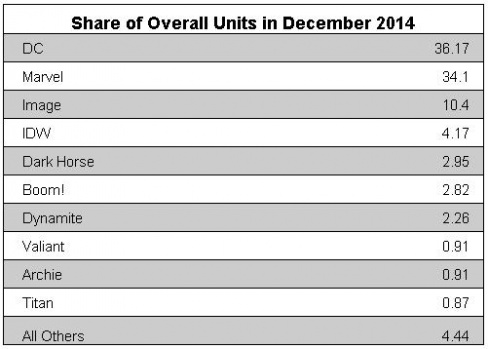
Small Press is a term with many meanings. To some people, it’s defined by content. To others, it’s decided by market share or the size of the print run. It actually has a specific meaning in the UK, but Small Press Month is going be focused solely on the US side of things (for now, anyway). Before we can move on with our other articles for the month, we need to look at the different ideas of small press and agree on who qualifies for the label. Let’s start from the top.

The Big 2
Comic readers have been dreaming for years about the day when there won’t be a big two anymore. As Image grows in market share, talk of the “big three” becomes more common. Still, there’s are two good arguments for why small press can be reduced to anyone who isn’t Marvel or DC.
Argument the first: walk into a comic shop and look at the arrangement for back issues and trades. More than likely, Marvel and DC are in a different section than all the other publishers, and maybe even from each other. If your local shop isn’t like that, then you’ve been to one that is. Even Barnes and Noble segregates them. There are good reasons for this, of course. Marvel and DC books comprise shared universes. Volume allows them to fill whole sections in a way few other publishers can. The end result of this grouping diminishes all non-big-2 publishers to the same category.
Argument the second: movie adaptations. When a movie is based on a Marvel property, it’s a Marvel Movie. When a movie is made from a DC property, the DC logo is front and center. When a book from Dark Horse or Top Shelf is turned into a film, their logos are…not there. Sometimes there’s a line of text saying it’s based on a graphic novel, but even then the publisher is usually left out. A major part of this is creator rights, of course, and that’s not a bad thing. Still, it increases brand awareness for the big two and diminishes it for everyone else.
Small press month is taking a more nuanced view of things though, and this is not the basis for who’s small.

The Premiere Five
In the monthly “Previews” catalog, there are five publishers who warrant special sections ahead of the alphabetical listings that include the other eighty-odd publishers. They are: Dark Horse, DC, IDW, Image, and Marvel. Marvel even gets its own catalog, which can be purchased independent of the main book. Not only do they get preferential locations, they also get additional space for each listing. Many of the new or most popular titles get full pages to themselves, and in some cases multiple pages for previews. Other books typically get half a page, and rarely less than a quarter page. Together, these five account for about 85% of sales to the direct market. The favorable treatment for the top five, or rather the lack of it for the bottom eighty, can be seen as an indicator of who is big and who is small.

The Top Ten
When asked if they consider themselves to be small press, both Dynamite and Boom! said no, they see themselves as top 10 publishers. According to Comichron, the top ten includes the Premiere Five, Dynamite, Boom!, Valiant, Archie, and Titan. Together, these publishers make up over 90% of the direct comic market. That figure makes a compelling case for the watershed between big and small press, but it’s a little too nebulous. It can change from month to month, and the final numbers can only be found through a third party well after the fact. Surely there’s an easier method to distinguish small press.
The Middle Class
Everyone other than the Premiere Five are listed alphabetically in the green pages of previews, but those pages are not doled out equally. Some publishers, including the Top Ten, receive specialized sections within the green pages that are formatted specifically to that publisher’s needs. This means their logo is prominent, the layouts are adjusted to maximize attention, and certain books warrant quarter, half, or even full pages for their solicitation. These publishers occupy a middle class in the comic industry; they’re too major to be minor, but still too minor to be major. Their ranks include Avatar, Oni, Viz, and Zenoscope.
Here, finally, is where Small Press Month draws the line. Any comic publisher who is too small to earn middle class treatment qualifies to have their books showcased in the Small Press Spotlight.
But wait! There’s more!
The Micro Press
There are an uncounted number of comics who aren’t carried by Diamond and aren’t available through Previews. These are the micro press, with tiny print runs that are hand sold by creators at conventions and local outlets. They require more effort to find, but if they’re widely available through the web or the mail, they qualify for the Spotlight treatment as well.
Be sure to check back tomorrow for more Small Press Month coverage, and share your opinion on where the small press line is drawn in the comments!






